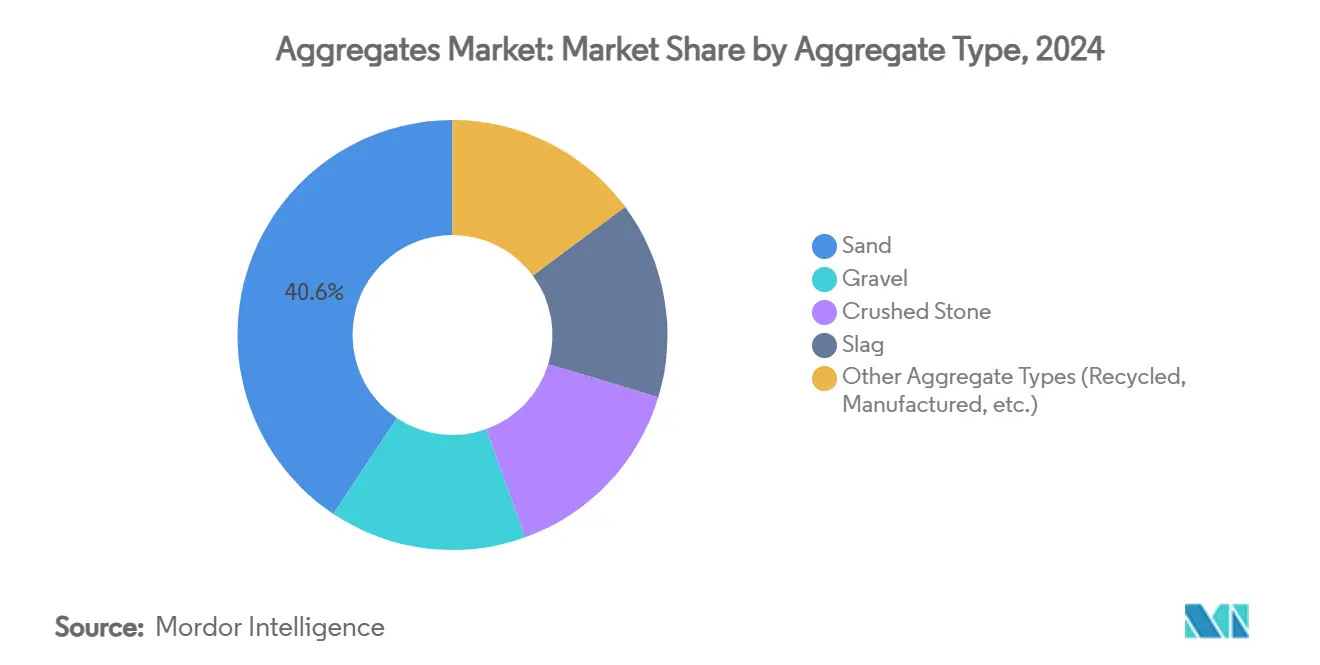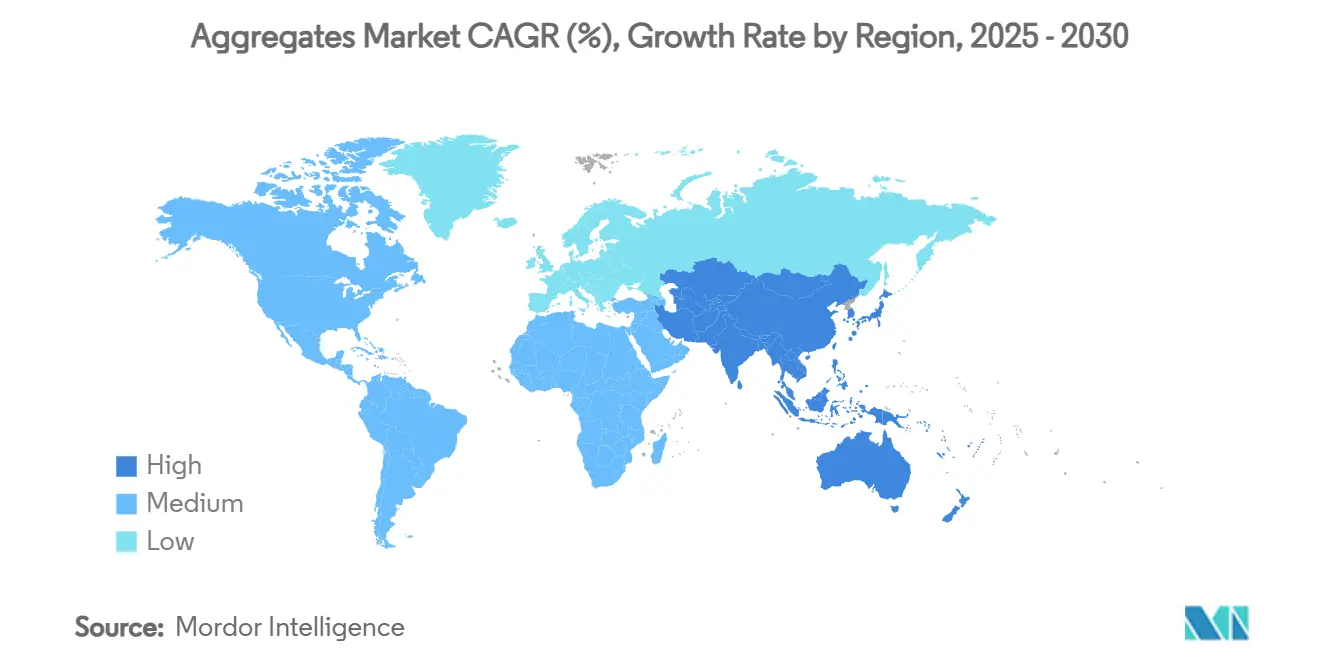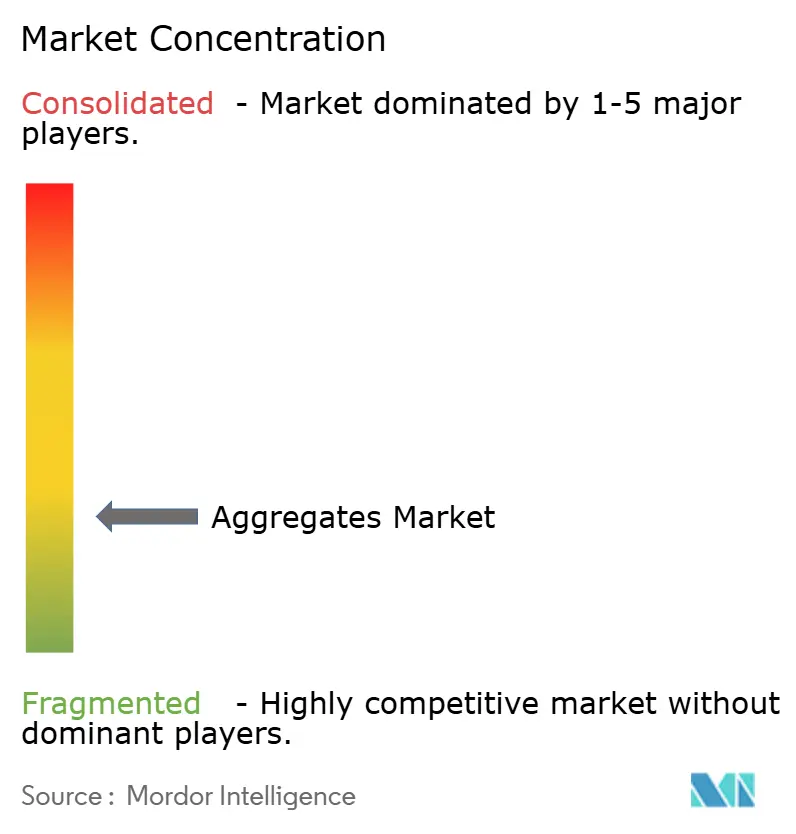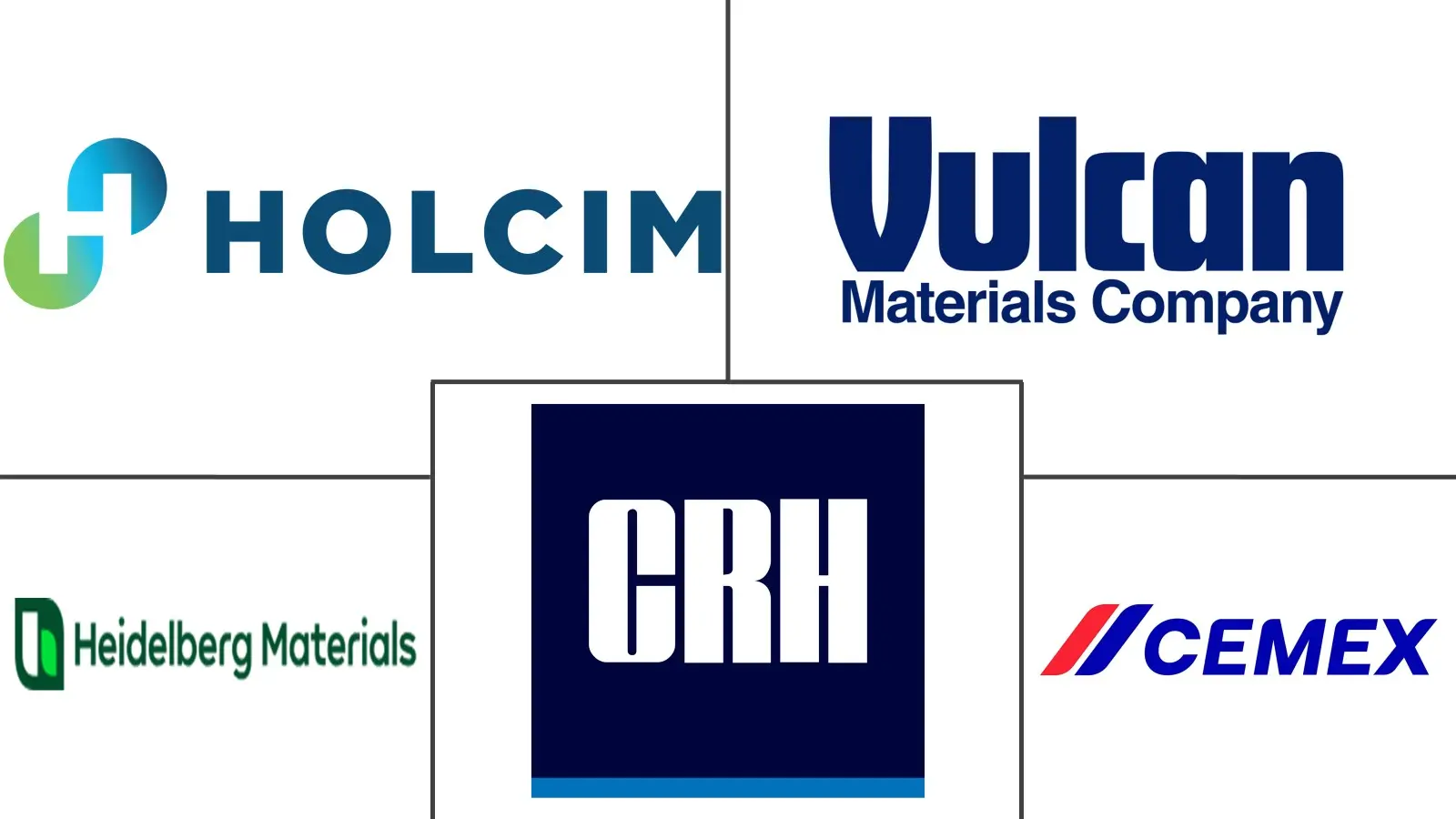Aggregates Market Size and Share

Aggregates Market Analysis by Mordor Intelligence
The Aggregates Market size is estimated at 58.67 Billion tons in 2025, and is expected to reach 79.52 Billion tons by 2030, at a CAGR of 6.27% during the forecast period (2025-2030). Rising governmental capital-expenditure programs designed to modernize roads, railways, ports, and renewable-energy sites anchor the growth outlook. Demand also benefits from rapid urbanization in emerging economies, widening adoption of ready-mix concrete, and public-sector incentives for low-carbon building materials. Leading producers are deepening vertical integration so that quarry ownership, asphalt, and ready-mix operations share logistics and procurement efficiencies, while circular-economy mandates accelerate investments in recycled aggregates processing. However, high diesel costs inflate haulage expenses, time-consuming environmental approvals delay new quarries, and regulators increasingly scrutinize recycled materials for micro-plastic contamination, creating compliance hurdles.
Key Report Takeaways
- By aggregate type, sand led with 40.65% revenue share in 2024, while other aggregate types are projected to expand at a 7.88% CAGR through 2030.
- By application, construction accounted for 47.52% of the Aggregates market share in 2024 and other applications are forecast to grow at 7.75% CAGR to 2030.
- By geography, Asia-Pacific captured 52.55% of the Aggregates market in 2024 and is advancing at a 7.42% CAGR to 2030.
Global Aggregates Market Trends and Insights
Drivers Impact Analysis
| Driver | (~) % Impact on CAGR Forecast | Geographic Relevance | Impact Timeline |
|---|---|---|---|
| Surging Infrastructure Spending, Especially in Emerging Asia-Pacific Markets | +1.5% | Asia-Pacific core, spill-over to MEA | Medium term (2-4 years) |
| Rising Adoption of Ready-mix Concrete Driving Demand for High-spec Aggregates | +1.2% | Global | Short term (≤ 2 years) |
| Government Stimulus for Low-Carbon Construction Solutions | +0.8% | North America & EU | Long term (≥ 4 years) |
| Circular-economy Mandates Boosting Use of Recycled Aggregates | +0.7% | EU core, expanding to North America | Medium term (2-4 years) |
| Internet of Things (IoT)-enabled "Smart Aggregates" for Structural Health Monitoring | +0.6% | North America & EU | Long term (≥ 4 years) |
| Source: Mordor Intelligence | |||
Surging Infrastructure Spending in Emerging Asia-Pacific Markets
China’s five-year plan requires 3,800 km of additional high-speed rail lines by 2025, a target that alone necessitates tens of millions of tons of ballast, sand, and crushed stone. Parallel investments in nuclear energy from 58.08 million kW installed in 2024 to 70 million kW by 2025 further expand concrete demand for reactor bases and ancillary facilities. India’s 2024-25 Union Budget raised capital outlays by 17.1% to INR 11.1 lakh crore (USD 134 billion), with 24.5% earmarked for the Ministry of Road Transport and Highways, propelling quarry output for highways, bridges, and metro corridors. Across Asia, transport infrastructure needs of USD 43 trillion between 2020 and 2035, of which 63% is dedicated to roads, cement the region’s status as the prime growth engine for the construction aggregates market [1]Asian Development Bank, “Meeting Asia’s Infrastructure Needs,” adb.org. Smart-city programs in Indonesia, Vietnam, and the Philippines add specialized demand for permeable aggregates used in green pavements and stormwater management systems.
Rising Adoption of Ready-mix Concrete Requiring High-Spec Aggregates
Ready-mix concrete plants now dominate urban supply chains, pushing baseline specifications for gradation, shape, and cleanliness of aggregates used in high-strength mixes. Aggregate Industries opened a 120 m³/hour plant in Birmingham in 2024, emphasizing low-carbon ECOPact concrete, illustrating how formulation changes ripple back to quarry operations that must supply more precisely crushed and washed stone. US residential-construction sentiment is expected to firm as the Federal Reserve guides policy rates to 5.5% by mid-2025, sustaining premium-grade aggregate demand in housing and data-center builds. Highway refurbishments funded by the Bipartisan Infrastructure Law require Superpave asphalt mixes demanding cubical, low-absorption aggregates derived from advanced vertical-shaft impact crushing lines. Emerging data-center and Artificial Intelligence (AI)-compute campuses specify aggregates that support concrete mixes engineered for thermal mass and electromagnetic shielding, opening high-margin niches for mineral fillers rich in magnetite or hematite.
Government Stimulus for Low-Carbon Construction Solutions
Ireland now mandates low-carbon cement on all state-funded projects, banning high-emission CEM I from September 2024 and forcing at least 30% clinker replacement. Similar procurement rules in Scotland and Wales favor local, lower-carbon aggregates that minimize haul distances. London’s Circular Economy Statement framework obliges major developers to retain building materials in situ where feasible, raising demand for aggregates compatible with deconstruction-ready design. The United Kingdom’s timber-construction roadmap may cap aggregates growth in some building segments, yet hybrid timber-concrete systems still require lightweight, high-performance fills for composite floors and shear walls.
Circular-Economy Mandates Boosting Use of Recycled Aggregates
European Union directives stipulate a 70% recycling rate for construction-and-demolition waste, prompting member states to refine multi-stage crushing and selective-separation lines capable of producing aggregates with <5% water absorption, thereby matching virgin-material performance in structural concrete. The Netherlands, Belgium, and France operate closed-loop logistics where Construction and Demolition Waste (CDW) is pre-sorted on site, hauled to regional hubs, and processed into certified aggregates, allowing concrete plants to achieve 5% recycled content in everyday mixes without redesign. The US Federal Highway Administration’s guidance to prioritize recycled materials in roadway projects secures a steady end-market, especially for reclaimed asphalt pavement blended into base courses. Laboratory studies show that replacing 20% of virgin coarse aggregate with recycled concrete aggregate balances mechanical performance and CO₂ savings, a specification now embedded in several European national standards.
Restraints Impact Analysis
| Restraint | (~) % Impact on CAGR Forecast | Geographic Relevance | Impact Timeline |
|---|---|---|---|
| High Transportation and Handling Costs | -0.4% | Global | Short term (≤ 2 years) |
| Stringent Environmental Permitting for New Quarries | -0.3% | North America & EU | Medium term (2-4 years) |
| Volatility in Diesel Prices Impacting Quarry Opex | -0.8% | Global | Short term (≤ 2 years) |
| Micro-plastic Contamination Concerns in Recycled Aggregates | -0.2% | EU core, expanding to North America | Long term (≥ 4 years) |
| Source: Mordor Intelligence | |||
High Transportation and Handling Costs
Diesel-fuel expenses can equal 25% of delivered aggregate price when average haul distances exceed 50 miles. Research shows that trimming haul routes by 15 miles could cut 178 million truck-miles, save 23 million gallons of fuel, and avoid 238,000 tons of CO₂ yearly, translating into USD 446 million of logistical savings. Rail is 3-times more fuel-efficient than trucks, yet only 9% of United States shipments move by rail because limited sidings and opaque rate-setting deter adoption [2]Agg-Net, “Rail Freight Challenges for UK Aggregate Producers,” agg-net.com. Fuel-price volatility following geopolitical events magnifies budget risk, and carbon-pricing schemes in the EU raise freight surcharges, prompting some contractors to substitute locally available yet lower-quality aggregates to stay within project budgets.
Stringent Environmental Permitting for New Quarries
Opening a greenfield quarry in Minnesota demands a Conditional Use Permit, Wetland Conservation Act compliance, and an environmental assessment that can run 24 months, adding soft costs up to USD 1 million before a shovel turns. Texas obliges annual registration of Aggregate Production Operations and triennial air-quality inspections, with Title V permits required for larger crushers, creating multi-year compliance budgets. Operators must commission traffic, dust, and salmon-habitat studies in environmentally sensitive California counties, design 25-foot setbacks from riparian zones, and post reclamation bonds, collectively swelling capital outlays and delaying revenue generation. Where permitting risk is perceived as high, listed producers prefer bolt-on acquisitions of existing quarries, a strategy visible in CRH, Heidelberg Materials, and Vulcan deals that redeploy capital away from uncertain greenfield developments.
Segment Analysis
By Aggregate Type: Sand Dominance Faces Recycled Challenge
Sand commanded 40.65% of the Aggregates market in 2024, reflecting its indispensable role in ready-mix concrete, plaster, and asphalt. At 6.27% CAGR, sand remains aligned with the overall Aggregates market trajectory as urban mega-projects across Asia and the Middle East sustain bulk demand. Gravel follows, preferred for road bases and drainage layers, while crushed stone supplies precise gradation for structural concrete and bridge decks. The Aggregates market size attributed to sand is projected to climb steadily, but permit caps on river-sand extraction in China, Vietnam, and Malaysia shift volumes toward manufactured sand sourced from basalt and granite.
Other aggregate types, including recycled concrete, manufactured sand, and lightweight synthetics, represent the fastest-growing slice at a 7.88% CAGR. Recycled concrete aggregates now meet national-standard water-absorption and Los Angeles-abrasion limits, allowing use in structural elements for the first time in Germany and the Netherlands. Cemex’s Berlin plant processes 400,000 tons of CDW annually, signalling commercial-scale viability and offering a template for other urban nodes [3]Cemex, “Cemex Acquires RC-Baustoffe Berlin,” cemex.com. When a London office tower reused 25% recycled aggregate in its floor slabs in 2024, embodied-carbon intensity fell by 12%, a metric increasingly embedded in asset valuations. As property developers chase green-building credits, the construction aggregates market share of recycled materials is poised to widen beyond its current single-digit level.

Note: Segment shares of all individual segments available upon report purchase
By Application: Construction Segment Drives Infrastructure Boom
Construction accounted for 47.52% of global aggregate volumes in 2024, spanning highways, high-speed rail bases, airports, and residential towers. The Aggregates market size for this segment will continue to grow as Asia invests USD 43 trillion in transport corridors up to 2035, with 63% for roads that consume base and sub-base aggregates by the million-ton lot. Ready-mix concrete production lines up granular demand; a single 60-storey tower can embed 20,000 tons of sand and stone. Railway ballasts and tunnel-boring operations in China, India, and the EU prescribe angular, hard-rock chips, often granite or basalt, reinforcing the criticality of geological diversity in supply chains.
Insulation uses vermiculite, perlite, and lightweight expanded shale, representing a small but profitable niche tied to energy-efficient building codes. Other applications from data-centre slab foundations that dissipate thermal loads to offshore-wind anchor grout are advancing at 7.75% CAGR and narrowing the gap with mainstream construction. As AI-compute demand boosts hyperscale-data-centre builds in the United States and Ireland, aggregates containing magnetite fill roles in electromagnetic-shielding concrete. The construction aggregates market continues branching into such engineered uses where performance premiums offset logistics costs.

Note: Segment shares of all individual segments available upon report purchase
Geography Analysis
Asia-Pacific held 52.55% of global volume in 2024 and is pacing at 7.42% CAGR to 2030. China’s need for 3,800 km of new high-speed rail by 2025 and a nuclear-power-capacity uplift of 11.9 million kW push quarry production to records, while India’s INR 11.1 lakh crore capital program enriches demand for crushed granite, especially in the Golden Quadrilateral highway upgrades. Japan invests in earthquake-resilient transport arteries and seawall refurbishments, sustaining orders for hard-rock rip-rap.
North America ranks second: United States quarries shipped 2.52 billion tons in 2023 valued at USD 36.8 billion, a 12.5% year-over-year gain, on the back of the Bipartisan Infrastructure Law and manufacturing-onshoring wave. Canada accelerates rail-grade separations in Ontario and British Columbia, while Mexico’s nearshoring adds industrial parks along the Bajío and northern corridors that favour limestone. Robust public budgets and an anticipated interest-rate easing cycle underpin 2025-26 pour volumes.
Europe maintains stable, policy-driven consumption. European Union (EU)-wide Construction and Demolition Waste (CDW) recycling mandates create pull-through for secondary aggregates, particularly in Germany, France, and the Nordics, where public procurement favors low-carbon alternatives. Scandinavia’s emphasis on passive-house standards lifts demand for lightweight insulation aggregates. South America and the Middle East & Africa trail but exhibit pockets of acceleration: Saudi Arabia’s NEOM (New Future) project sources granitic gabbro from domestic quarries, and Brazil revives its federal-road-maintenance backlog, each injecting incremental demand into the global construction aggregates market.

Competitive Landscape
The Aggregate market is fragmented with major players such as HOLCIM, Cemex S.A.B DE C.V., CRH, Heidelberg Materials AG, and Vulcan Materials Company. CRH purchased Martin Marietta’s Texas cement and ready-mix assets for USD 2.1 billion in 2024, integrating a 2.1 million-ton-capacity plant with 20 batch plants to capture transport synergies. Heidelberg Materials AG spent USD 380 million on three US bolt-ons, including Highway Materials with four quarries and nine asphalt plants, reinforcing its Mid-Atlantic presence. Technology adoption widens competitive gaps. Artificial Intelligence (AI)-enabled demand forecasting cuts idle inventories, and tele-remote drilling rigs lower labor exposure in blast zones. Smart-aggregate patents open a future revenue stream for early movers that can scale sensor-embedded stone.
Aggregates Industry Leaders
-
Vulcan Materials Company
-
HOLCIM
-
Cemex S.A.B DE C.V.
-
Heidelberg Materials AG
-
CRH
- *Disclaimer: Major Players sorted in no particular order

Recent Industry Developments
- November 2024: Summit Materials, Inc. entered into a definitive agreement to be acquired by Quikrete Holdings, Inc. for USD 11.5 billion, including debt. The transaction combines Summit Materials, Inc.'s aggregates, cement, and ready-mix concrete businesses.
- July 2024: Heidelberg Materials AG announced a definitive purchase agreement to acquire Highway Materials, Inc., one of the largest independent aggregates and asphalt producers in the Greater Philadelphia market. The acquisition encompasses four crushed stone quarries, nine hot-mix asphalt plants, two clean fill operations, a concrete recycling facility, and a construction services business.
Global Aggregates Market Report Scope
Aggregate is a broad category of coarse to medium-grained particulate material used in construction activities, which includes sand, gravel, crushed stone, slag, recycled concrete, and geosynthetic aggregates.
The market is segmented by Aggregate Type (Sand, Gravel, Slag, Crushed Stone, Other Aggregate Types), Application (Construction (Buildings, Railways, Roadways, Others), Insulation, Other Applications), and Geography (Asia-Pacific, North America, Europe, South America, Middle East and Africa). The report also covers the market sizes and forecasts for the aggregates market in 15 countries across major regions. For each segment, the market sizing and forecasts have been done in terms of revenue in USD million.
| Sand |
| Gravel |
| Crushed Stone |
| Slag |
| Other Aggregate Types (Recycled, Manufactured, etc.) |
| Construction | Buildings |
| Railways | |
| Roadways | |
| Others | |
| Insulation | |
| Other Applications |
| Asia-Pacific | China |
| Japan | |
| India | |
| South Korea | |
| ASEAN Countries | |
| Rest of Asia-Pacific | |
| North America | United States |
| Canada | |
| Mexico | |
| Europe | Germany |
| United Kingdom | |
| France | |
| Italy | |
| Spain | |
| Russia | |
| NORDIC Countries | |
| Rest of Europe | |
| South America | Brazil |
| Argentina | |
| Rest of South America | |
| Middle East and Africa | Saudi Arabia |
| South Africa | |
| Rest of Middle East and Africa |
| By Aggregate Type | Sand | |
| Gravel | ||
| Crushed Stone | ||
| Slag | ||
| Other Aggregate Types (Recycled, Manufactured, etc.) | ||
| By Application | Construction | Buildings |
| Railways | ||
| Roadways | ||
| Others | ||
| Insulation | ||
| Other Applications | ||
| By Geography | Asia-Pacific | China |
| Japan | ||
| India | ||
| South Korea | ||
| ASEAN Countries | ||
| Rest of Asia-Pacific | ||
| North America | United States | |
| Canada | ||
| Mexico | ||
| Europe | Germany | |
| United Kingdom | ||
| France | ||
| Italy | ||
| Spain | ||
| Russia | ||
| NORDIC Countries | ||
| Rest of Europe | ||
| South America | Brazil | |
| Argentina | ||
| Rest of South America | ||
| Middle East and Africa | Saudi Arabia | |
| South Africa | ||
| Rest of Middle East and Africa | ||
Key Questions Answered in the Report
What is the current size of the Aggregates market?
The Aggregates market size is 58.67 Billion tons in 2025, with a forecast to reach 79.52 Billion tons by 2030.
Which region leads global demand for aggregates?
Asia-Pacific holds 52.55% of global volume, supported by large-scale infrastructure programs in China, India, and Southeast Asia.
Why are recycled aggregates gaining momentum?
European Union circular-economy mandates and lower-carbon procurement policies encourage the use of recycled aggregates, which now meet structural-grade performance standards and offer embodied-carbon savings of roughly 12%.
How are transportation costs affecting aggregate prices?
Diesel volatility and long haul distances can add up to 25% of delivered cost, prompting producers to seek rail alternatives, site quarries closer to markets, or pursue acquisitions that shorten supply chains.
What role do smart aggregates play in the market?
Internet of Things (IoT)-enabled smart aggregates embed sensors that monitor concrete curing and structural health, opening premium opportunities in critical infrastructure such as bridges and high-rise buildings.
Page last updated on:



